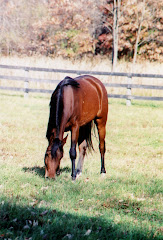 When I was nine years old I read Black Beauty for the first time. When I turned to the last page, I knew at that moment I wanted to be an author, and I wanted to write about horses. It has taken me a while to get to this point, but I am now in the ranks of "struggling writers" who work odd jobs here and there to pay the bills so there is time left in the day to do what makes our hearts sing ~ write.
When I was nine years old I read Black Beauty for the first time. When I turned to the last page, I knew at that moment I wanted to be an author, and I wanted to write about horses. It has taken me a while to get to this point, but I am now in the ranks of "struggling writers" who work odd jobs here and there to pay the bills so there is time left in the day to do what makes our hearts sing ~ write.Anna Sewell, the author of Black Beauty, was also 51 when she wrote her first and only novel. Although her mother was a well known Quaker author of children's fiction and verse, Anna had never shown any particular inclination for writing. But after witnessing an incident of cruelty to a carriage horse, she felt moved to write in their defense. Out came one of the best loved novels of all time.
Anna had been crippled since she was a child, and at the time she wrote the book she was not expected to live for another 18 months. To begin a book while halfway to her deathbed might have looked pointless, especially when she could never sit to read or write for longer than a few moments. At times she became so weak from writing that she had to stop and rest for days at a time.
Her writing progressed with agonizing slowness between long bedridden stretches. Her eighteen months came and went. She was still alive, though close to death. But she lived another eighteen months, and another eighteen, and another still. In August 1877 she made one of the final notes in her diary: My proofs of Black Beauty are come—very nice type.
The completed story recounts the life and times of the well-bred horse of the title, and such stable companions as gentle Merrylegs and the angry and spirited Ginger; echoing throughout the book is the memory of Black Beauty’s mother Duchess, with her admonitions to stay gentle and mannered at all times. Surrounding these horses is a procession of good, bad, and indifferent owners: the well-meaning but inept rookie Joe Green, the drunkard Reuben Smith, the cruel cab driver Nicholas Skinner. Sewell sold this story, and all its rights, to the publishing house Jarrold & Sons for the staggeringly cheap advance of £20. But she was wise to get her cash up front.
Anna Sewell may have died with only an additional £20 in her pocket, but what she left the world through her book has made her legacy far richer in honor and decency than any other author I know.
Parts of this post are taken from an article by Paul Collins.







+of+DallasGrazing.jpg)


